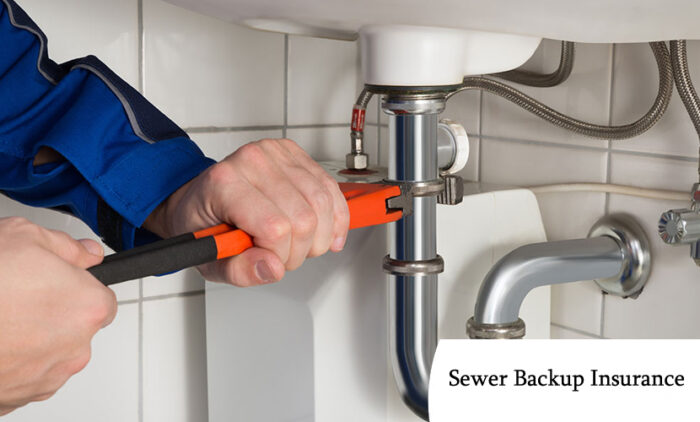Sewer backup insurance provides protection against the financial consequences of sewage accumulation in various areas of your home, such as the bathtub, toilet, basement, and other locations.

This insurance coverage assists in covering expenses related to repairing your sewer line, extending up to the city’s sewer line, and addressing the cleanup of sewage and water within your property.
Sometimes referred to as water backup insurance or drain line backup coverage. This type of policy safeguards homeowners from the costs associated with sewer backups caused by different factors.
In the event of sewer backup, this insurance can be instrumental in mitigating the expenses incurred from restoring your sewer system and eliminating sewage and water from your residence.
By offering financial support for repairs and cleanup efforts, sewer backup insurance ensures that homeowners are protected from the financial burden of addressing such incidents, which can be both damaging and costly.
Additionally, this coverage, known by various names like water backup insurance and drain line backup coverage, serves as an important safeguard against the potential financial repercussions of sewer backups, providing peace of mind to homeowners facing such unforeseen challenges.
How Does It Work?
Sewer backup insurance is an important component of home insurance that requires homeowners to opt for this coverage, as it is not automatically included in standard plans.
This type of insurance serves as an additional endorsement to your existing policy, offering protection specifically against sewer backups.
Unlike overland flood or water damage policies, sewer backup insurance provides essential coverage for scenarios where sewage water enters your home, particularly through drains, septic tanks, downspouts, pipes, and eaves troughs.
This specialized insurance is vital for homeowners with finished basements, basement apartments, or significant items stored in the basement, as it covers the costs of repairing or replacing damaged belongings, which can amount to substantial expenses reaching up to $30,000 or more for repairs to drywall, flooring, insulation, and appliances.
By adding this extra layer of protection to your policy for an additional cost of around $100 per year, homeowners can avoid the financial burden of out-of-pocket expenses in the event of a sewer backup.
When considering the purchase of sewer backup insurance, several factors should be taken into consideration to determine its necessity and relevance to your specific circumstances.
Elements such as your property’s elevation in relation to sea level, the density of your neighborhood concerning the sewer line, and the frequency of severe weather events play a significant role in assessing the need for this coverage.
Additionally, understanding the frequency of reported claims and sewer flooding incidents can provide valuable insights into the potential risks and benefits of acquiring sewer backup insurance.
Some insurance providers may mandate the installation of a backwater valve as a preventive measure, especially in areas prone to sewer backups.
Also, in cases where significant damage has occurred, the installation of such a valve may be required to secure future insurance coverage.
Is Sewer Backup Coverage Included In Homeowners Insurance?
Typically, a standard homeowner’s insurance policy does not automatically incorporate sewer backup coverage.
However, many home insurance providers offer it as an optional add-on or endorsement to the primary homeowners’ insurance policy. This endorsement provides a specific amount of coverage for sewer or water backup claims.
To illustrate, consider two scenarios where sewer backup coverage. If included as an endorsement in your homeowners’ insurance policy, would likely cover the resulting damages:
In the context of a severe storm, a sump pump malfunction leads to water accumulation in your finished basement, damaging your children’s playroom, their toys, and other personal belongings, as well as causing structural damage to the property.
Tree roots penetrate the septic line outside your home, resulting in sewage backup into your residence, flooding it with sewer water.
Consequently, all personal belongings in the basement must be replaced, and your yard requires excavation to repair the damaged septic pipe and remove the tree roots.
Causes Of Sewer Backup
The occurrence of sewage backing up into your residence can stem from various factors, ranging from minor leaks to significant flooding. All of which can result in costly property damage. Some common causes of sewer backups include:
Clogged Pipes
Drain pipes can easily become obstructed due to a variety of reasons, such as inadequate maintenance practices, flushing non-biodegradable items down the toilet, or disposing of large amounts of food waste down the sink.
Ignoring these clogs can escalate the issue, potentially leading to sewer backups in different areas of your home.
Tree Roots
Strong tree roots can infiltrate underground pipes, causing them to break or collapse, ultimately resulting in sewer backups.
It is important to address slow drains and unusual sounds promptly to identify and potentially prevent tree roots from causing damage to your sewer system.
Damaged Line
A damaged line connecting your property to the main sewer line can also trigger sewage overflow into your home.
If you suspect that a broken line is the cause of the sewage backup, it is advisable to contact your local municipal authorities for assistance and necessary repairs.
What Does It Cover?
- Protection against unexpected water intrusion through drains, septic tanks, downspouts, pipes, and eaves troughs.
- Common causes include clogs in sewer lines, heavy rainfall or snowmelt, and outdated sewer systems.
- Covers cleanup, repairs, and restoration of affected areas and personal belongings.
- Essential for comprehensive protection in the event of a sewer backup.
What It Does Not Cover?
- Not all water-related claims are covered.
- Consider adding overland water insurance and water damage insurance for broader coverage.
- Damages resulting from neglected, regular maintenance are not covered.
- Some insurers offer comprehensive water-related packages to safeguard against various water intrusion scenarios.
Is Sewer Backup Worth It?
The decision to invest in sewer backup insurance hinges on several factors, most notably the location of your property and its history of experiencing sewer backups.
For homeowners residing in areas prone to flooding, this insurance is a valuable addition, as the cost of adding a rider significantly outweighs the expenses associated with cleanup and repair, which can easily exceed $10,000.
When assessing the worthiness of sewer backup insurance, it is essential to consider the specific risks and benefits associated with your property.
For instance, if you reside in an area with a history of homes experiencing backups, investing in this insurance can provide peace of mind and financial protection against potential damages.
However, if your property is located in a region with minimal risk of sewer backups, the added cost of this insurance may not be justified.
Therefore, a thorough evaluation of your unique circumstances is necessary to determine the value and relevance of sewer backup insurance for your home.
Strategies For Preventing Sewer Backups
- Purchase a home in a low-risk flood area on high ground, avoiding large trees that can cause plumbing problems.
- Regularly maintain drains by using them properly and avoiding the introduction of harmful substances, such as grease or coffee grounds, and non-degradable items, like wipes or sanitary products.
- Schedule professional sump pump servicing every few years to prevent clogs and ensure efficient operation.
- Promptly address plumbing issues to avoid costly repairs and potential sewer backups, basement flooding, and other problems.
- Install a backwater valve to prevent excess water from entering your home during city main drain backups.
- Position downspouts three to six feet away from your home and use rain barrels or gardens for rainwater collection.
Frequently Asked Questions
How To File A Sewer Backup Insurance Claim?
If you experience a sewer backup, contact your utility department’s 24-hour emergency line to report the backup.
Have the cleanup done immediately to minimize potential damage, and photograph the “before” and “after.”
Itemize any losses or damage to your belongings or home, save all receipts related to repairs, cleaning, or damages; and contact your insurance professional to start a claim if you have sewer backup insurance.
How Much Does Sewer Backup Insurance Cost?
The cost of sewer backup insurance varies depending on the insurer and the coverage limits. Typically, it ranges from $40 to $250 per year, with an average cost of around $100 to $150 per year.
However, the cost may be higher in areas with a higher risk of sewer backups or for homes with finished basements or valuable belongings stored in the basement.
Is Sewer Backup Insurance Mandatory?
No, sewer backup insurance is not mandatory. However, experts highly recommend it for homeowners, especially those residing in low-lying areas, near bodies of water, or in older neighborhoods with aging infrastructure.
Sewer backups can cause significant damage to your home, and without insurance. So, homeowners may be responsible for the cost of repairs and cleanup.
Can I Purchase Sewer Backup Insurance Separately Or Is It Only Available As An Endorsement To My Home Insurance Policy?
Sewer backup insurance is only available as an endorsement or rider to your home insurance policy. This is because insurance companies do not sell it as a standalone policy.
Therefore, homeowners can contact their insurance provider to add this coverage to their existing policy for an additional premium.



